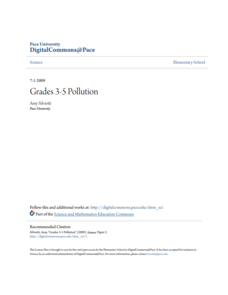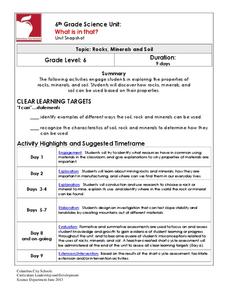Denver Art Museum
The Poetry in Non-Events
The photograph, Nellie and her Italian Soda is viewed and discussed by the class. They are instructed to use the photograph as inspiration to write a poem about non-events, or things that are beautiful in every day life. Pupils use a...
Curated OER
Non-Defining Relative Pronouns Exercise
Writing flows better with complex and compound sentences. Teach your learners how to combine sentences using relative clauses. This activity has 10 questions, but there are no examples provided. Consider providing at least a few examples...
Curated OER
Hey Diddle Diddle
Students discuss their needs to grow and be healthy. They listen as the teacher explains the definition of "organisms" and "nonliving" Students identify organisms in the classroom. They listen to and view a poster illustrating the "Hey...
Pennsylvania Department of Education
Animal Classes and Their Ecosystems
Students explore animal characteristics by participating in an environment identification activity. In this animal habitat lesson, students discuss a range of different wild life and the ecosystems that they are a part of. Students view...
Curated OER
Investigate Science Using Crayfish
Young scientists discover the importance of scientific investigation by observing live crayfish. They carefully observe the patterns of crayfish in different environments. Then they discuss their conclusions and define what all living...
Alliance Theater
The Jungle Book Post-Show STEAM Lesson
An ecosystem is really just the flow of energy through many different living organisms. A study of Rudyard Kipling's The Jungle Book leads to an environmental science activity in which learners study how various factors can affect...
Curated OER
Can You "Gas" What's Happening?
Students examine gas production in "soil" samples through hands on activities and class discussions, to determine if the soil samples have contain living or non-living systems.
Curated OER
Parts of Ecosystems
In this ecosystem worksheet, students brainstorm and write down as many living and nonliving things found in an ecosystem. This worksheet is a graphic organizer.
Curriculum Corner
Guest Teacher Plans (Grade 2)
Be prepared the next time you're in need of a substitute with a daily plan equipped with an assortment of activities covering subjects math, reading, word work, writing, and science.
K20 LEARN
It's Alive! Or, Is It?
Seems like a fairly simple question—until you begin asking your class! Get pupils acquainted with the characteristics of life through pairs classification, discussion, and scientific reading. The lesson plan, part of the K20 series, also...
Pace University
Pollution
Over the course of 10 days, scholars take a pre-assessment to place them in one of three leveled groups. Whole-class and in small groups, pupils take part in read-alouds, field trips, hands-on activities, and complete learning contracts...
Curated OER
Life Systems- Zoo Central
Students investigate the various aspects associated with living things while also concentrating on their basic needs. They explore the aspects of movement and growth in plants and animals. This is done through research and other...
Columbus City Schools
What is in that?
Invite your class to dig in to an engaging journey into the world of mining! Here you'll find the tools to equip young miners with knowledge of soil, rocks, and minerals, as well as types of mining operations. To round things out, the...
Curated OER
Living, Non-Living Mobile
Middle schoolers are introduced to the concept of living and nonliving organisms in general and participate in a starter activity where they build their own definitions of living and nonliving organisms.They sort organisms into living...
Curated OER
Creating Nonviolence: A Theatre of the Oppressed Approach to Things Fall Apart
Eleventh graders analyze Ahimsa and complete activities for nonviolence. For this nonviolence lesson, 11th graders define violence and relate it to their lives. Students adapt prose into a dialogue to act out and analyze the violence in...
Curated OER
Abiotic and Biotic Factors
Learners examine abiotic and biotic factors. They define biotic and abiotic, categorize a list of items onto a Venn diagram, label various items from areas on the school grounds as biotic or abiotic, and diagram a magazine picture.
Curated OER
Watch Them Grow
Students explore the growth of plants and animals. Through research and observation, students create a habitat for specific plans and animals. As a group, they examine the similarities and differences of living things. Students identify...
Curated OER
A Tree is an Ecosystem
Young scholars make observations about trees. In this ecosystem lesson, students observe and record all living and non living things they find under a tree, look for birds nests, evidence of woodpeckers and take samples such as leafs,...
Curated OER
Biodiversity
Students complete activities to study the importance of biodiversity. In this biodiversity lesson plan, students find images to categorize into organism groups and illustrate their interconnections. Students use measurement tools to...
Curated OER
Mini-Ecosystems
Third graders identify the living and non living things in a book read aloud and discuss the interactions represented in the book. Then, they research and include a list of food that each animal needs in an ecosystem. Finally, 3rd...
Curated OER
Renewable vs. Non-Renewable Resources
Fifth graders identify renewable vs. non-renewable resources and comprehend why conservation of resources is important. They are asked what they think the words natural and resource mean. Pupils then put the words together to define...
Curated OER
BBC Learning English, Listening Comprehension
In this specific listening comprehension learning exercise, students listen to an audio file and then choose the best answer to 15 corresponding multiple choice questions. Students then respond to four questions about non-verbal...
Curated OER
Looking at the Community Tree
Third graders review the characteristics of living and nonliving organisms. As a class, they observe a tree and describe the interactions between the living and nonliving organisms surrounding it. To end the instructional activity,...
Curated OER
Vegetable Colors
In this vegetables learning exercise, students draw a label some green vegetables. Students then draw a label some non-green vegetables. Students then tell where non-green vegetables grow.
Other popular searches
- Living and Non Living Things
- Living and Non Living Things
- Living vs Non Living Things
- Living Non Living Things
- Living Non Living Things
- Laving and Non Living Things
- Living Non Living Organisms
- Living vs. Non Living Things
- Living vs Non Living Things
- Lving and Non Living Things
- Living, Non Living Things
- Living/non Living Things

























